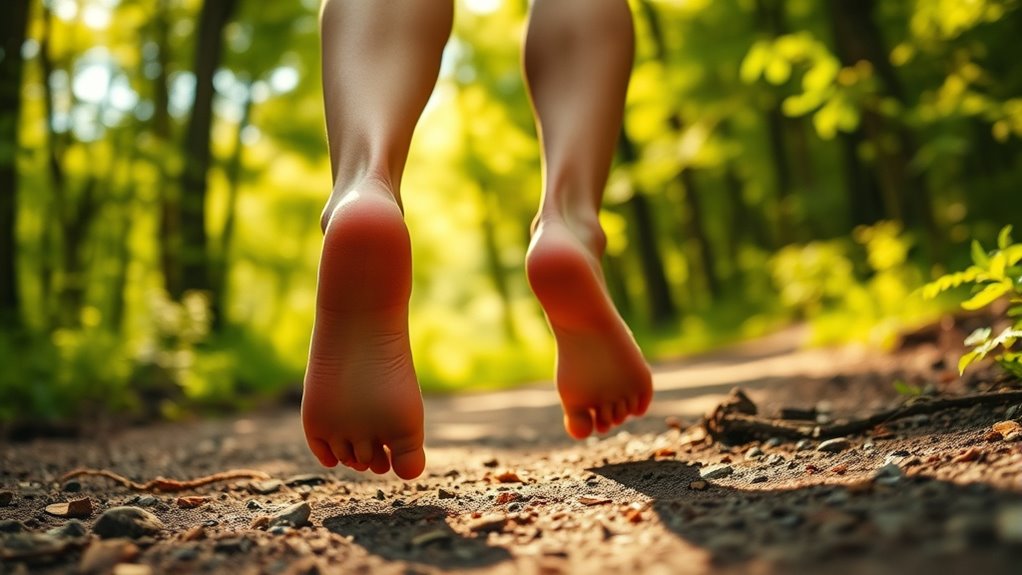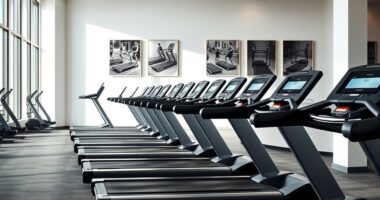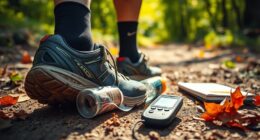Barefoot running taps into the way humans originally moved, as our ancestors ran without shoes for centuries. Recent years have seen it grow in popularity, with claims that it promotes natural movement, improves foot muscle strength, and reduces injury risks. However, it also carries risks if you jump in too quickly. Moving properly and understanding its history can help you decide if it’s right for you—keep exploring to learn more about its benefits and precautions.
Key Takeaways
- Human ancestors ran barefoot for centuries, emphasizing natural gait and foot strike patterns.
- Modern running shoes with cushioning became popular in recent decades, altering natural biomechanics.
- The barefoot running movement advocates for natural foot movement, aiming to reduce impact and enhance proprioception.
- Evidence shows benefits like improved foot strength, but transition must be gradual to prevent injuries.
- The hype combines historical roots with claims of injury prevention, though scientific consensus remains nuanced.

Barefoot running has gained popularity among athletes and fitness enthusiasts who believe it offers a more natural and efficient way to run. Many say that it helps you reconnect with your body’s natural movement patterns, especially when it comes to how your foot strikes the ground. When you run barefoot or in barefoot shoes, you tend to land more on the front or midfoot rather than the heel. This change in foot strike can reduce impact forces and potentially lower injury risk. Instead of pounding the ground heel first, your foot naturally adapts to land softer and more evenly, which some runners find improves comfort and running economy. Barefoot shoes, which mimic the feel of being barefoot but provide minimal protection, are designed to promote this natural foot strike. They usually have thin, flexible soles that allow you to feel the terrain and adjust your stride accordingly. The history of barefoot running traces back centuries, as humans originally ran without any footwear. It wasn’t until recent decades that modern running shoes became widespread, offering cushioning and support aimed at preventing injuries. However, some experts argue that these cushioned shoes may alter your natural foot strike, encouraging a heel-first landing that can increase impact stress. The barefoot running movement rekindled an age-old practice, emphasizing the importance of a foot strike that aligns with human evolution. Advocates often cite studies suggesting that barefoot running can improve proprioception—the sense of how your foot interacts with the ground—and strengthen the muscles in your feet and lower legs. Additionally, understanding the refrigeration cycle helps explain how footwear can influence foot health and injury prevention by supporting proper gait mechanics. Despite its appeal, barefoot running isn’t suitable for everyone. Transition to barefoot shoes requires a gradual approach—suddenly switching from heavily cushioned sneakers to minimal footwear can lead to injuries like stress fractures or calf strains. You need to build strength and adapt your gait slowly, paying close attention to how your foot strikes the ground. Proper technique involves landing gently with your foot directly beneath your hips, avoiding overstriding or excessive heel contact. Many runners find that focusing on their foot strike helps improve overall running form, but it’s essential to listen to your body during this changeover. If you experience pain or discomfort, it’s wise to consult a specialist to ensure your running style aligns with your body’s needs.
Frequently Asked Questions
Is Barefoot Running Suitable for All Foot Types?
Barefoot running isn’t suitable for everyone, especially if you have a high or flat foot arch or experience excessive foot pronation. You need to evaluate your foot type and pronation level before trying it. If you have any foot concerns or injuries, consult a specialist. Shift gradually, listening to your body, to avoid injuries. Barefoot running can work for some, but it’s not a one-size-fits-all solution.
How Does Barefoot Running Affect Long-Term Foot Health?
Think of your feet as the foundation of a house; barefoot running can strengthen them over time. Archaeological evidence shows ancient humans adapted biomechanically, which supports healthier foot development. Long-term, barefoot running may improve foot strength, flexibility, and arch support. However, it can also cause injuries if not shift gradually. You should listen to your body and adapt gradually, ensuring your foot health benefits from this natural form of movement.
Are There Specific Training Programs for Transitioning to Barefoot Running?
Yes, there are specific training protocols for shifting to barefoot running. You should follow a gradual adaptation approach, starting with short, slow sessions to let your feet adjust. Increase duration and intensity gradually over several weeks, paying attention to how your body responds. Incorporate strength and flexibility exercises to support your transition, and listen to your body to prevent injury. This way, you build resilience safely and enjoy the benefits of barefoot running.
What Are the Common Injuries Associated With Barefoot Running?
Did you know that 30% of barefoot runners report foot arch fatigue or Achilles strain? You’re more likely to experience these injuries if you don’t shift carefully. Barefoot running puts extra stress on your foot arch and Achilles tendon, leading to fatigue or strain. To avoid these issues, strengthen your foot muscles gradually and listen to your body, ensuring your stride adapts safely to the new style.
How Does Barefoot Running Influence Running Economy and Performance?
Barefoot running can improve your running economy and performance by encouraging a forefoot or midfoot strike pattern, which reduces impact forces. This shift increases muscle activation in your calves and foot muscles, making your legs more efficient. As a result, you may experience better energy transfer and reduced fatigue. However, progressing carefully is essential to avoid injury while adapting to these changes.
Conclusion
So, whether you’re tempted to ditch your shoes or stay on familiar ground, remember that barefoot running is like walking a tightrope—balancing tradition and innovation. It’s not a one-size-fits-all solution, but exploring this ancient practice can help you find what works best for your body. Keep an open mind, listen to your body, and don’t be afraid to take small steps. After all, every journey begins with just one barefoot step.









